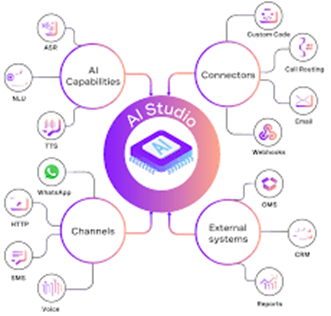The cloud communications space continues to be crowded and noisy, and even the established players are having difficulty breaking through to get anyone's attention for at least 10 seconds. These days, 10 seconds of attention is actually a big deal; plenty of time to fire out a few tweets to your legions of followers.
Aside from the Internet making us all borderline ADHD, we have too many endlessly evolving technologies to follow. There are lots of shiny technology balls out there vying for our attention, but none is shinier than artificial intelligence (AI). Every vendor now has an AI story, but it’s still poorly understood, so a lot of terms stick very easily – both positive and negative - making clear messaging a real challenge.
Things get even trickier when AI is tied to communications platforms as a service (CPaaS), the newest member of the cloud communications family. Unified communications as a service (UCaaS) and contact center as a service (CCaaS) are well-established now, and it’s pretty clear what those offerings do, who they’re meant for, and what the benefits are. CPaaS, however, is newer to the cloud communications milieu , and being the ultimate Swiss army knife, it’s capable of doing anything, with anyone and for anyone.
For those who natively understand CPaaS – i.e., developers – this versatility is no problem. It’s actually the attraction for them. For the rest of us, CPaaS' versatility is as amorphous as, well, AI. CPaaS has long been successful in the messaging space, but it’s a more recent entry for collaboration and contact center needs; and doesn’t really slide into any niche neatly and tidily—yet. The good news is that CPaaS has unlimited use cases, and in the right hands, those use cases can all be good. The unlimited use cases are also bad news, especially when vendors try to inject new value into UCaaS or CCaaS – without a specific use case, CPaaS can just be a solution looking for a problem.
Here's How Vonage is Approaching the Opportunity
Make no mistake – CPaaS could well be the solution that prevents UCaaS and CCaaS from fossilizing into me-too, price-driven commodities. That Jurassic Park scenario is a real possibility, as there are only so many features you can keep adding to these platforms, much like the arms race we’re seeing now between Zoom and Microsoft Teams.
AI is another driver for long-term differentiation to keep UCaaS and CCaaS vital, and that’s why every vendor has an AI story now. However, not every vendor in these spaces has a CPaaS story yet—but we’re getting there. Keep in mind that CPaaS players don’t really need to be in UCaaS or CCaaS to be successful. Many have done very well in the mobile messaging world, but that space is reaching its own limits, so they’re definitely looking for new growth vectors , and UCaaS and/or CCaaS still offer lots of upsides.
This brings us to Vonage and its
recently-launched AI Studio. Trying to differentiate with CPaaS alone is one thing; it’s another to try this just with AI, and what makes this a bold move for Vonage is trying to do both CPaaS and AI at the same time. AI Studio has all the elements of an AI offering for contact centers in terms of enhancing customer experience (CX) and automating workflows. Such as natural language understanding (NLU) to enable chatbots to use conversational AI (CAI) or virtual assistants to help agents provide more personalized CX in real-time.
Switching over to CPaaS, AI Studio provides all the building blocks developers need to shine—such as no code/low code applications, and perhaps most importantly, an extensive – and global – API partner ecosystem. The latter is a key secret sauce for Vonage and, in my view, one of the main reasons Ericsson bought them.
But Wait, There’s More
AI Studio is focused on a hot market opportunity – CCaaS – so they’re on target here, but they’re hardly alone. This brings us to the challenge of breaking through the noise with a value proposition that resonates. Vonage is not the first entry for bringing AI to CCaaS, and it’s important to understand just how crowded things are getting , both in terms of the number of players, as well as the variety and types. It would take an entirely separate post to deconstruct how complex the competitive landscape is , so here’s the Reader’s Digest condensed version.
First, consider the CCaaS vector, where the leading contact center pure-plays hold court; NICE has Chatbot Builder. Genesys also has Dialog Engine Flow Builder as part of Cloud CX, Five9 has IVA (via their Inference acquisition), and Avaya has Experience Builders as part of its OneCloud CC.
Adjacent to this would be players who have strong native platforms across all three offerings – UCaaS, CCaaS and CPaaS. A few to mention would be Cisco, Dialpad and IntelePeer, but the list runs much longer. They’re all coming to market with AI-driven CPaaS capabilities – just not quite the same applications as AI Studio – at least for now.
Then you have CPaaS pure-plays like Twilio with Studio, which leverages their developer-focused expertise to support Flex in the CCaaS space. Whereas the likes of Twilio offer turnkey solutions for developers that can be deployed to augment – or in lieu of – existing contact center setups, there is also a bottomless pit of pure-play chatbot builders, many of whom are focused on this particular space.
This vector of chatbot builders is rooted in the developer world – especially those doing conversational AI. While many names may not be familiar to No Jitter readers, they have a key role to play as third-party partners such as Deepgram, Freshdesk, Juji, Kore.ai, MobileMonkey and Sprinklr. Developers follow the money, and for companies like these, they are well aware of the problem sets and pain points that contact centers are struggling with.
What’s Vonage Got That the Others Don’t?
To be perfectly honest, I’m not entirely sure, and it’s too soon to know, anyhow. I’m not writing this post to drive leads to Vonage; rather to explain why I think AI Studio represents an inflection point as to where things are at with both AI and CPaaS.
Coming back to the starting point of my analysis, how on earth is Vonage going to break through – not just for clarity about AI and CPaaS, but to stand out from this impossibly messy mix of players who are all capable of doing similar things?
The starting point for me is the fact that Vonage has native capability across all three cloud platforms – CCaaS, UCaaS, and CPaaS (via Nexmo), as well as AI, via acquisitions like Over.ai. To varying degrees, many competitors have these capabilities as well—and all I can say is that Vonage integrates these pieces via their VBC platform – yes, Vonage does that.
More to the point, the CPaaS market has evolved to where there are now two distinct audiences for vendors to engage with. First would be the developers, who have always been the target for CPaaS pure-plays like Twilio. For developers, offerings like AI Studio are a sandbox to build whatever their customers want or what they think the market is ready for. By their nature, developers will be the vanguard of innovation. And as they move deeper into the CCaaS space, their impact will be felt, either selling directly, or as third-party partners with both CPaaS and CCaaS vendors.
Vonage has plenty to offer them with AI Studio, and it should hold their own in this crowded field of competitors. As noted earlier, they have a rich API ecosystem, which all developers want, along with a large, global customer base for them to build for (and will only grow as part of the Ericsson fold).
The second audience is where I think Vonage is coming to market at the right time: IT leaders. Developers are not the conventional routes to market for either UCaaS or CCaaS, and a key reason why CPaaS has been slow to take hold in these spaces is the long-held preference for turnkey solutions. Aside from this being easier for IT leaders, they don’t generally have the inclination and/or expertise for DIY projects. When it comes down to build or buy, they’re more likely to buy, especially for the new frontiers of both AI and CPaaS.
This approach represents the path of least resistance for end buyers, and incumbent contact center vendors will do well supporting them with prepackaged apps with lots of AI and plenty of CPaaS DNA that end customers don’t need to know much about. Vonage certainly plays well on that count, but what makes AI Studio a bold move is offering the best of both worlds for IT and contact center leaders. If you want a developer-led chatbot to do any number of things, Vonage has plenty of those in their ecosystem. AI Studio provides unlimited flexibility to build exactly what you want.
There is, however—another path opening up that diverges from being least resistance. By playing its CPaaS hand, Vonage can now also cater to contact centers that want even more control. This is where the no code/low code aspect of AI Studio comes into play, as it enables end customers to build their own chatbots and virtual assistants, even with just minimal developer expertise.
Vonage recognizes that the AI market has matured enough, whereby end customers can create their own applications in-house. No code/low code is the big enabler here, and this option simply wasn’t available at scale until now but is poised to accelerate the adoption of CPaaS in spaces like CCaaS and UCaaS.
Considering how there are three threads to weave together to address this opportunity effectively – AI, CPaaS, and CCaaS – many vendors can do one or two of these very well, but far fewer have a strong hand for all three. While Vonage isn’t alone in bringing all of these options to market—with AI Studio—it’s doing it at the right time where the value proposition should resonate across these various audiences.
This post is written on behalf of BCStrategies, an industry resource for enterprises, vendors, system integrators, and anyone interested in the growing business communications arena. A supplier of objective information on business communications, BCStrategies is supported by an alliance of leading communication industry advisors, analysts, and consultants who have worked in the various segments of the dynamic business communications market.












